Jeanne Dore and Joan Cancilla’s house sits between Drummer Cove and Blackfish Creek in Wellfleet. At this time of year, the water glimmers through the pitch pines at high tide, but, like most of the Outer Cape in late winter, it’s a landscape without much color.
Dore, a retired nurse, found a remedy for that. She had seen pictures of bottle trees — a tradition in the American South — and set out to make her own full-color version. The only problem was the soft boughs of the pine trees in the couple’s yard wouldn’t cooperate with her vision. She enlisted the help of her partner, Joan, to erect an old post in their yard and drill long screws into it, on which she placed dozens of blue bottles. “It’s beautiful in the snow and when the sun is shining on it,” says Dore.
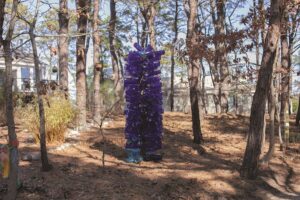
That was 15 years ago. Since then, the grove has expanded. The original three-foot bottle tree is now joined by a few others. The transfer station, a source of much local creative inspiration, has been crucial to the development of her yard art.
“I asked the guys there to put aside colored bottles for me,” says Dore. They obliged, but nearly all of them were the same cobalt blue color. She had imagined a multicolored tree, but she went ahead and worked with the limited palette.
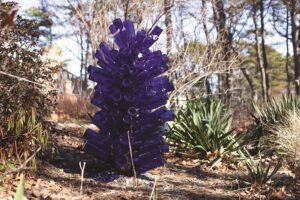
“A lot of them are Skyy vodka bottles,” Dore says, a fact that worried at least one neighbor. When her second, larger tree went up, she recalls, “A neighbor came by and said, ‘My son is very concerned because he thinks you have an alcohol problem.’ ”
Otherwise, she’s generally found a warm reception for her bottle trees. Pedestrians walking by on their way to the marsh occasionally stop to take photographs. “Sometimes people leave blue bottles by the mailbox, which is sweet,” says Dore. The extra bottles come in handy for sprucing up her trees — she loses 10 or so bottles to winter winds each year.
The tradition of building bottle trees stretches from the southern United States back to Africa, where they were seen as a way to bottle up evil spirits, Dore says.
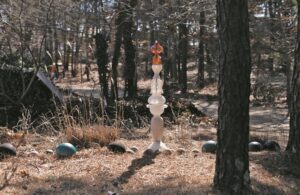
The art historian Robert Farris Thompson has traced the tradition to the Bakongo people of West Africa, who were brought here as enslaved people. And Felder Rushing, a Mississippi writer and horticulturist whose blog provides an extensive rabbit hole on bottle trees, says their origins are in Egypt and Mesopotamia. Around 1600 BCE, hollow glass bottles began appearing, and stories, including the one about Aladdin, suggested that spirits could live inside them.
Rushing, who writes that he has made “dozens of different bottle trees and spent half a century photographing thousands of them,” describes them as “the folksiest form of garden art” and “redneck Chihuly sculptures.” Thompson identifies East Texas, southeastern Arkansas, and southern Alabama as bottle-tree hot spots.
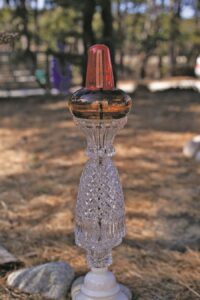
Dore’s most recent bottle tree is multicolored. It’s a small tree. “The bottles are on a glove holder used to put near your fireplace,” she says. Her bottle trees share the yard with a number of other creative projects. Often an idea begins with something she’s collecting. “I’ve been collecting rocks for years,” she says.
Consequently, Dore has a few rock gardens, including one of white stones surrounding a rhododendron and another interspersed with glass knobs collected from the tops of bottles. Her latest project is a debris line composed of a rope on which she hangs colorful bits of plastic collected during walks on the beach. “People can come by and weave something in,” she says. “It’s kind of an interactive piece.”
Not everyone is enthusiastic about that one. “My neighbor told me, ‘It’s not up to your usual standards,’ ” Dore says, laughing.
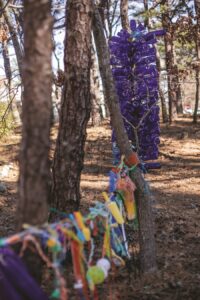
Her collections usually begin with beachcombing or at the Wellfleet swap shop. “Going to the swap shop gets you thinking, what can I do with that?” says Dore. Over time she has collected lamps, usually with clear or white bases. She has arranged them into curvaceous vertical sculptures. On a March morning one of them glimmers, reflecting the dappled sunlight drifting through the trees.
“In the winter, when you don’t have anything blooming,” Dore says, “it’s nice to have some color and sparkle.”
Editor’s note: Because of reporting, editing, fact-checking, and proofreading errors, an earlier version of this article, published in print on March 23, misspelled Jeanne Dore’s name. The Independent regrets this mistake.
